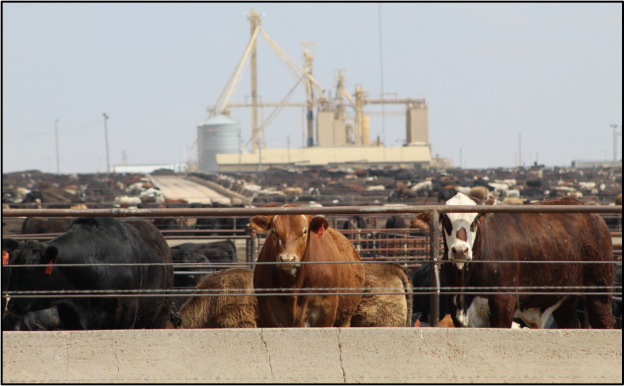The following post is one of a series previewing the research that will be presented at the (SciCon2), 15–19 November 2020.
A guest post by Eric Peterson, Texas Tech University
Imagine driving down a country road on a clear, beautiful summer evening, when you see what looks like fog across the road in front of you. As you drive closer and closer, your car becomes engulfed, and you can no longer see the telephone poles in front of you. After a few hundred meters or so of this “fog,” you emerge on the other side, and it is once again clear. While it may sound like a scene out of the Stephen King novel The Mist, and more of a science fiction scenario, it is actually a phenomenon that occurs on a nightly basis all across the High Plains of the United States of America (US). The true culprit of this “fog” is actually dust emanating from beef cattle feed yards on a nightly basis.
Where does your beef come from?
To meet growing demands of beef across America and the rest of the world, production of beef cattle has become a highly regulated and finely tuned machine. The Great Plains of the US contain some of the largest cattle herds in the country, producing thousands of calves every year. Once these calves have been weened and are big enough to ship, they are transported to beef cattle feed yards to “finish out.” Finishing cattle entails feeding the animals high-protein diets to encourage rapid muscle production and optimize the fat percentages required for slaughter.
Odds are, if you bought beef at the grocery store or ordered a hamburger in a restaurant, you ate beef that was finished on a beef cattle feed yard. Feed yards’ main objectives are to mass produce beef. Thus, feed yards diligently work to have cattle put on weight and reach the desired size as quickly as possible. Feed yards receive calves throughout the year, creating a mixture of age classes and allowing for continual beef production and revenue. As a result, feed yards have a relatively constant numbers of cattle throughout the year.
Since cattle on feed yards are not actively grazing, they do not need to cover large tracts of lands. Therefore, feed yards are able to house thousands of cattle in relatively small areas. The average feed yard contains around 40,000 cattle, whereas large feed yards may cover two square kilometers and house over 100,000 head. As you can imagine, with this many cattle in such a small area, feed yards produce massive amounts of waste. While there are many management practices aimed at addressing this issue, feed yard operations are unable to adequately control all of the waste generated.
Aerial transport of waste
As described above, the “fog” coming off of feed yards is actually dust being generated by the thousands of cattle on the feed yard. Most feed yards in the US are built in semi-arid environments that receive relatively small amounts of precipitation throughout the year. Additionally, these regions have high sun intensity, low humidity, and near constant wind. All of these factors combined create an environment that is prone to droughts and aids in the ability to dry pen-floor material (primarily urine and manure) on feed yards. In the evening, when the sun begins to set and temperatures decrease, cattle become more active, pulverizing the dried floor material creating dust. When enough cattle start running around the pens and suspending the floor material, it creates this fog scenario. With a little bit of wind, this dust then drifts off of the feed yard and into the local environment. It is estimated that there is enough dust coming off of feed yards across the US to fill over 570 truck beds full each night! Over the past decade, it has become apparent that this dust coming off of feed yards also contains commonly used veterinary pharmaceuticals given to cattle to increase growth and promote health; for example, steroids and antibiotics.
Investigating transport of pesticides
While steroids and antibiotics commonly given to cattle on feed yards have been analyzed in dust, there are no data determining if pesticides are also present. The focus of my team’s project was to determine if pesticides, commonly used on beef cattle feed yards, are transported beyond their boundaries via dust. We collected dust alongside feed yards from March until October and analyzed samples for a variety of pesticides. Interestingly, we found multiple different insecticides and at potentially alarming rates. The highlights of our study include: the determination of a novel transport mechanism for a new class of insecticides, the presence of pesticides that are banned in Europe, and the identification of restricted use pesticides in the dust samples collected. A presentation at the SETAC North America Annual Meeting titled “” will dive deeper and reveal what pesticides were found. Further, data will be presented on potential impacts these insecticides could have on surrounding organisms like pollinators and honey bees. This research was also recently published in .
Presentation information for SciCon2:
1.04.01 –
3.04.11 –
1.04.03 –


Thank you for an enticing introduction to your research. It certainly captured my attention and serves to remind us that chemistry effects the world around us, going from point-source pollution to fate & transport.